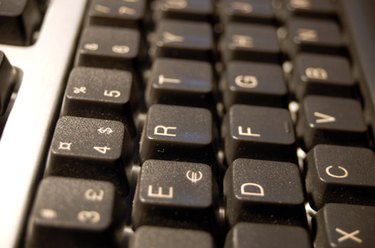
In computing, hardware refers to all the physical, tangible components that take up space. Unlike software, which are programs necessary for the computer to run, hardware can be seen and touched. All computers, whether desktop or laptop, have some common hardware components, the only difference being the size and capabilities of the individual components. In a desktop computer, the tower casing houses internal components such as the hard disk, RAM, motherboard and optical drives, while the peripheral devices such as the monitor, keyboard and mouse are external components.
Hard Disk
Video of the Day
The hard disk drive is a rectangular, metallic box found inside a desktop computer's tower casing. All the information in a computer, including the OS (operating system), installed applications and programs and user documents are stored in the hard disk. At any given time, a computer operator only works on a small portion of all the data stored in a computer's hard disk. For example, when you are working on a word processor, other applications such as the Web browser and DVD player are not being used, but they are still stored in the hard disk. When you download a file, or install a software, you record the information on the computer's hard disk.
Video of the Day
RAM & Processor
Like the hard disk, a computer's RAM (random-access memory) and processor are also internal components. RAM modules fit into predefined slots on the motherboard, and the total RAM of a computer depends on the capacities of the individual modules. When a user opens a program, the computer loads it on RAM from the hard disk, because the RAM is much faster, and the processor can manipulate RAM data more efficiently. When the program is closed, all data associated with the program is unloaded. In essence, the RAM is the computer's work bench, where only information needed at the time is temporarily stored for the processor to work on.
Input & Output Devices
A computer uses input devices to take instructions from the operator. Common input devices include the keyboard, mouse, scanner, microphone and webcam. Without an input device, a user would not be able to feed information to, or interact with a computer; when you click on the Web browser icon and type in a URL, you are using the mouse and keyboard to instruct the computer to execute certain processes. Output devices such as the display monitor, speakers and printer enable the computer to give information back to the user after executing tasks. When the computer displays a Web page, it has already taken an input from the user (the typed-in URL), and processed the information before giving feedback through its monitor.
Removable Media
Optical drives such as CD-ROM and DVD-ROM and the now obsolete floppy-disk drive, are examples of removable media, which are usually held inside the tower casing. Removable media allow a computer to access information that is not stored inside the hard disk. When you insert a DVD to watch a movie, the computer is able to play the content because the DVD-ROM is able to access the data on the disc and forward it to the computer. Another type of removable media is flash drives, which are small USB-based devices used to store and transfer data between computers.